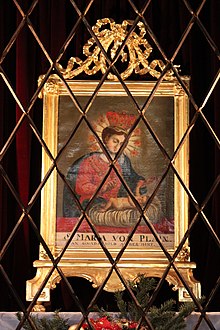Image of grace Maria Plain
The miraculous image of Maria Plain , a so-called Maria-Trost-Bild , is the miraculous image of the pilgrimage church on the Plainberg in the municipality of Bergheim in the state of Salzburg . It comes from the city of Regen , the answers to which it is said to have been answered led to the foundation of the pilgrimage sites Maria Plain and Maria Trost above Nesselwang . A total of four similar Maria-Trost pictures have survived.
Archetype
The original, created by an unknown painter, was miraculously spared during the Thirty Years War when the town of Regen in Lower Bavaria burned down in 1633. The baroness Argula von Grimming, wife of the highest guardianship officer in Regen , exchanged the sooty painting and had it installed in her castle chapel. After her death, her son Rudolph von Grimming inherited the so-called Maria-Trost-Bild, who initially brought it to his noble residence in Müllegg in Salzburg , but then put it on the Plainberg in 1652 , which led to its admiration. As a result, a copy of the picture was made by Johann Franz Pereth , which remained on the Plainberg, while Rudolph von Grimming took the original picture with him on trips and on a pilgrimage to Einsiedeln . In 1658, when the Grimmings moved, the original first came to Nesselwang , then it was set up and venerated on an alpine meadow, on which the Maria Trost pilgrimage site developed. From 1665 to 1676 it was then in the episcopal ordinariate in Salzburg. In the years 1671–1673 Archbishop Max Gandolf von Kuenburg had today's church built. The original from the early 17th century was now placed on the high altar of the pilgrimage church first as a copy and then as an original in 1732.
The frame of the picture dates from 1679, it was provided with a halo in 1732 and decorated with rocailles and a crown in 1751 . During the War of the Austrian Succession (1740–1748), many people made pilgrimages to Maria Plain for fear of the impending armed conflict. When Salzburg was spared the aftermath of the turmoil of the war, the Salzburg Cathedral Chapter arranged for the cult object to be crowned by Andreas Jakob von Dietrichstein . Below the picture is a silver-embossed coat of arms of Archbishop Max Gandolph . At a later time, the miraculous image was called the miraculous image of Maria Trost . A copy of the miraculous image by the painter Christian Zach from 1657 is in the treasury of the Superiorat building in Maria Plain.
The image of grace is the knee of a seated crowned St. Mary, holding a diaper with both hands, on which the naked, crowned child is lying to the left on her lap and stretching out her hands to the mother, [with] 7 stars around the head of St. Maria [are]. In 1787 Hieronymus Colloredo was asked to remove the crowns, but the argument that only he as bishop could remove them because a bishop himself would have mounted them in 1751 prevented the removal.
Images of the archetype
- in a wayside shrine in Maria Plain, at the junction of Plainbergweg Grabenbauernweg, inscription 1738, renewed (see secret pillars on the way to Maria Plain )
- in the wayside shrine three brothers chapel in Elixhausen
- Altar with image in the Bürgerspitalkirche St. Blasius in Salzburg
- as a fresco from 1925 by Anton Faistauer at the St. Benedikt College in Salzburg
- in one of the oratorios of the Erhard Church in Salzburg
- as the motif of a special stamp issued by the Austrian Post on November 18, 2011
literature
- Dehio Salzburg 1986 , Maria Plain , pilgrimage church Maria Himmelfahrt, pages 225 to 229.
- Gustav Gugitz : Austria's places of grace in cult and custom . A topographical handbook on religious folklore in five volumes, Vienna 1958 (volume 5).
Web links
Individual evidence
- ^ Margot Luda and Franz Xaver Greß: Pilgrimage Church of Maria Trost Nesselwang in the Allgäu , Anton H. Konrad Verlag Weißenhorn 1986, p. 16.
- ↑ a b c Dehio Salzburg 1986 , pages 227ff
- ↑ namely Andreas Jakob von Dietrichstein
- ^ Gustav Gugitz: Austria's places of grace in cult and custom . A topographical handbook for religious folklore in five volumes, Vienna 1958, volume 5, p. 181.

